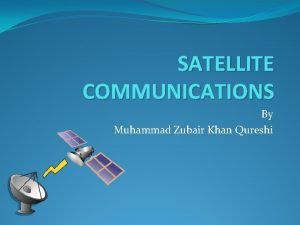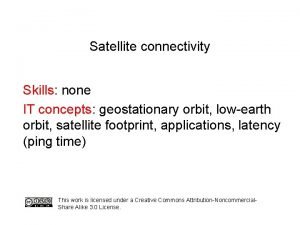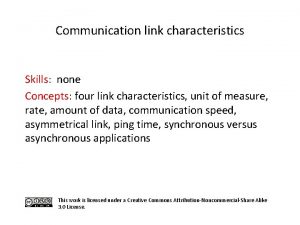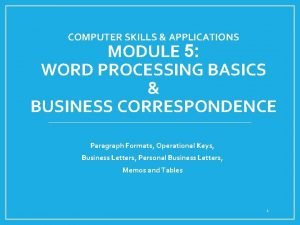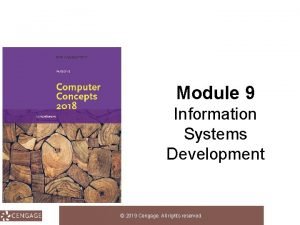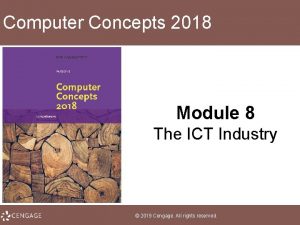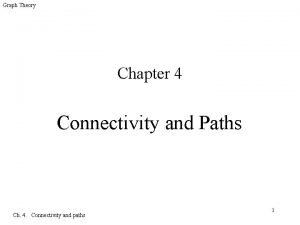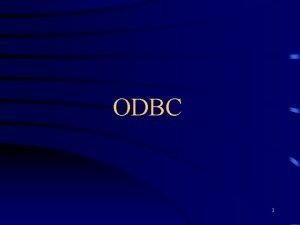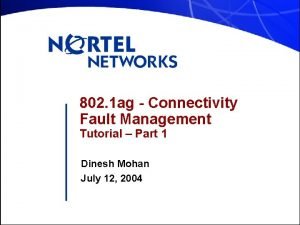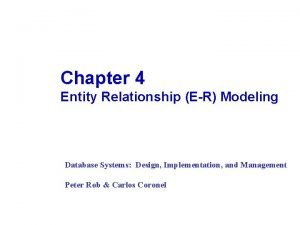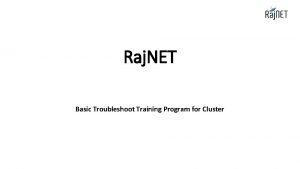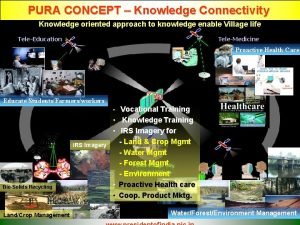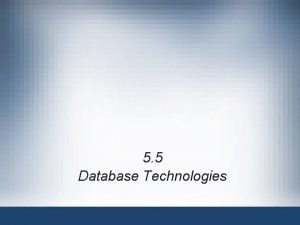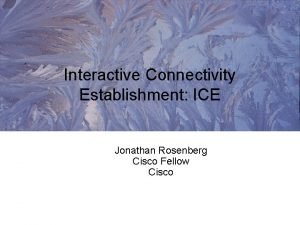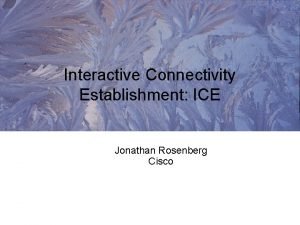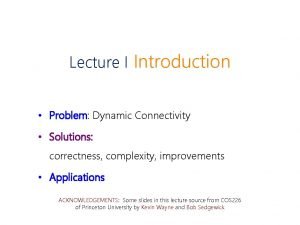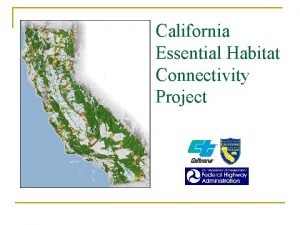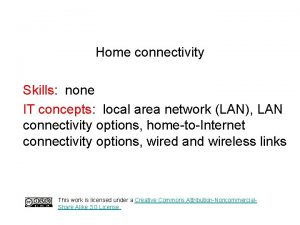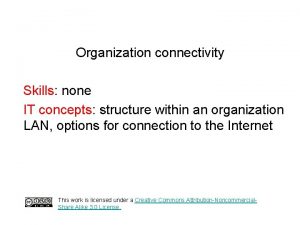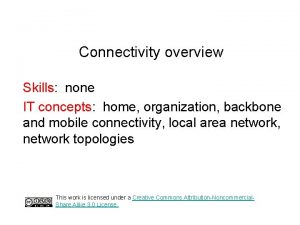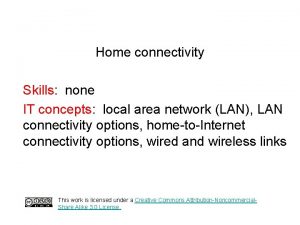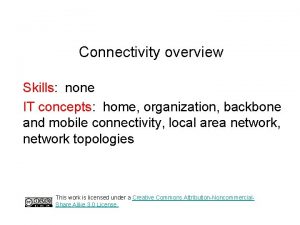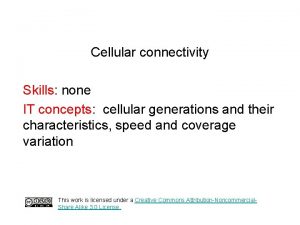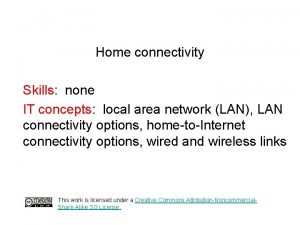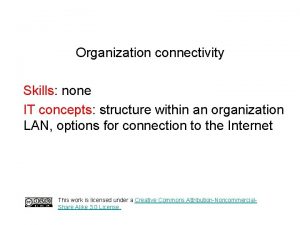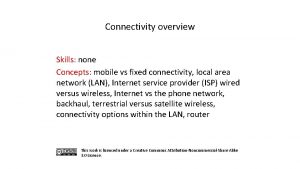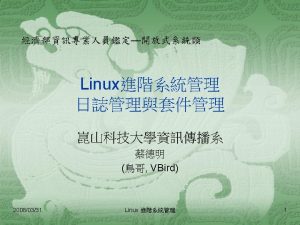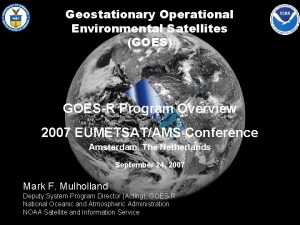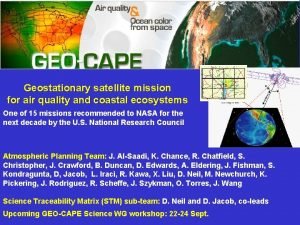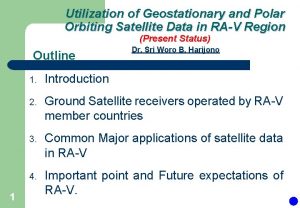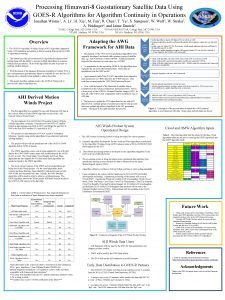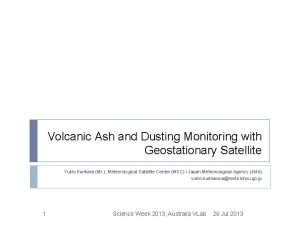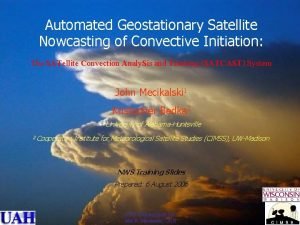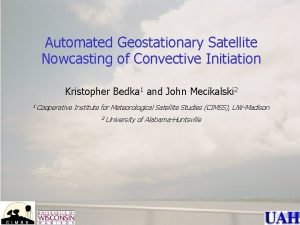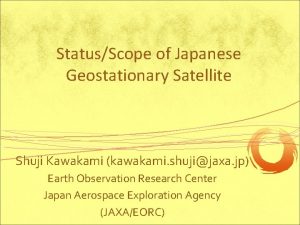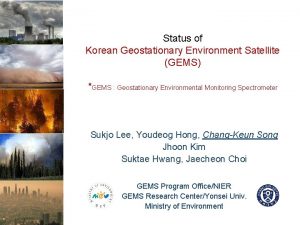Satellite connectivity Skills None IT concepts geostationary mediumEarth




























- Slides: 28

Satellite connectivity Skills: None IT concepts: geostationary, medium-Earth, and low-Earth orbit satellite characteristics, satellite footprint, Some evolving, critical technologies, LEO/MEO ISP competitors and the customers they hope to serve This work is licensed under a Creative Commons Attribution-Noncommercial. Share Alike 3. 0 License.

Where does this topic fit? • Internet concepts • Applications • Technology (communication) • Implications • Internet skills • Application development • Content creation (images)

Satellite orbit characteristics Orbit characteristics calculator Altitude (miles) Low-earth orbit (LEO) Medium Earth orbit (MEO) Geostationary orbit (GEO) < 1, 200 -22, 236 Latency Orbit time (milliseconds) (hours) 20 -25 110 -130 250 -280 Around 2 Around 12 24 Where would the moon be in this illustration? Why is the GEO altitude exactly 22, 236 miles while LEO and MEO are ranges?

GEO: The vision In 1945, Arthur C. Clarke proposed geostationary satellite communication in an article entitled “Extra Terrestrial Relays. ” He later wrote 2001 a Space Odyssey and other science fiction stories. Fig 2. Transmission from A being relayed to point B and area C; transmission from D being relayed to whole hemisphere.

GEO • Done for many years. • Used primarily for broadcast and slow, expensive rural Internet connectivity • Orbits in 24 hours, so remains fixed in the sky Animate

GEO • GEO ISPs and broadcast companies are well established. • GEO technology has and continues to improve. • Since the satellite appears to be stationary, the antenna does not have to move. What is unusual about the source of the image of the antenna in India?

MEO The US GPS geolocation services uses 24 sats at 12, 550 miles altitude. About 1/3 are typically available from a given location at a given time. China, Russia and the European Community also operate MEO geolocation systems. Animate Source

MEO - SES O 3 b • Leading MEO Internet service provider today • Satellites orbit at the equator • Serving maritime, airlines, governments and rural mobile operators • Will deploy significantly advanced “Mpower” satellites in the next two years O 3 b status

MEO & GEO O 3 b’s MEO satellites will interoperate with over 50 GEO satellites of their parent company SES. Animated source

LEO • Traditionally used for Earth imaging, and science • Large constellations for global Internet service being developed Teledesic failed in the 1990 s, what has changed since then to make newcomers optimistic? Teledesic constellation Animate

Moving “footprint” of a famous LEO satellite The International Space Station is in low-Earth orbit below the altitudes of the planned Internetservice constellations Live map

Satellite footprint • What will happen if the flashlight (satellite) moves farther away? • Where is the light the brightest?

Footprint example – LEO and VLEO (very low Earth orbit) Where would the strongest signal would be within the footprint?

Some evolving, critical technologies • Electronic beam switching and shaping • Inter-satellite laser links • Component reuse • Reflection mitigation • Debris mitigation • Layer integration

Electronic beam switching and shaping • • No moving parts fast switching Mass production Will improve Watch this location during animation. Animated source

Inter-satellite laser links • Speed of light communication • Central to fast long-distance links • Not yet ready for deployment Space. X’s original plan: • Five lasers per satellite • Four connect to northsouth neighbors • One connects to nearest east-west crossing satellite

Component reuse Fairing 2 nd stage • Satellites inside the fairing • Recovering boosters frequently fairing one time so far Booster

Fairing recovery Ms. Chief and Ms. Tree

Booster recovery The Falcon Heavy rocket uses three boosters. Here two land simultaneously. (The third tried to land on a barge, but failed). Very cool video

Reflection mitigation Reflection can interfere with astronomical observation. This image is shortly after launch. Satellites will rise to orbit and spread out. Elon Musk is 100% confident of solving this problem.

Debris remains an unsolved problem (but many people are working on it). As of last night, 8, 761 objects had been launched into outer space and 5, 293 were still in orbit (source). Space. X alone has permission to launch over 12, 000 satellites and has asked for 30, 000 more. There are many ideas for dealing with debris, including the illustrated here from Space. X (source).

Layer integration An integrated Internet with terrestrial, atmospheric, LEO, MEO, GEO and deep-space layers • SES MEO/GEO integration • Telesat using Google Loon software • Devising standards for 5 G mobile-satellite integration This is the start of an ongoing project for many years Source

Leading LEO/MEO constellation players • • Amazon Three Chinese companies Leosat O 3 b One. Web Space. X Telesat

LEO constellations hope to provide fast Internet connectivity for • • • Homes and organizations in poor and remote areas Ships at sea and other off-shore locations like oil rigs. Airplanes in flight Cellular networks and Wi. Fi hotspots Government agencies and large enterprises Inter-city and international backbone providers

While making a lot of money to pay for it But, the business model remains unproven.

Summary

Resources Track the progress of the Internet-service satellite projects here.

Self-study questions 1. I mentioned some leading companies a. Which one(s) is/are pursuing the consumer market? b. Which one(s) is/are pursuing other markets? c. What are some non-consumer markets for satellite connectivity 2. Which is best suited to the consumer Internet service market: LEO, MEO or GSO? 3. Which has a larger footprint: LEO, MEO or GSO? 4. Which has a longer latency time: LEO, MEO or GSO? 5. What is latency a measure of?
 Geosynchronous vs geostationary
Geosynchronous vs geostationary Geostationary orbit
Geostationary orbit Geostationary
Geostationary Geostationary
Geostationary Social skills none
Social skills none Victorian curriculum history scope and sequence
Victorian curriculum history scope and sequence Word processing packages
Word processing packages Fundamentals of nursing care concepts connections & skills
Fundamentals of nursing care concepts connections & skills Module 7 computer concepts skills training
Module 7 computer concepts skills training Module 8 computer concepts skills training
Module 8 computer concepts skills training Hard skils
Hard skils Essential skills ontario
Essential skills ontario Interpersonal skills and intrapersonal skills
Interpersonal skills and intrapersonal skills Edge connectivity
Edge connectivity Java data base
Java data base Data base 1
Data base 1 Connectivity fault management
Connectivity fault management What is multivalued attribute in er diagram
What is multivalued attribute in er diagram Pehchan.raj.nic.in login
Pehchan.raj.nic.in login Pura connectivity
Pura connectivity Ebics psd2
Ebics psd2 Brain connectivity
Brain connectivity Database connectivity in web technology
Database connectivity in web technology Interactive connectivity establishment
Interactive connectivity establishment Ecfps
Ecfps Ice interactive connectivity establishment
Ice interactive connectivity establishment Data base connectivity
Data base connectivity Connectivity correctness
Connectivity correctness California essential habitat connectivity project
California essential habitat connectivity project
